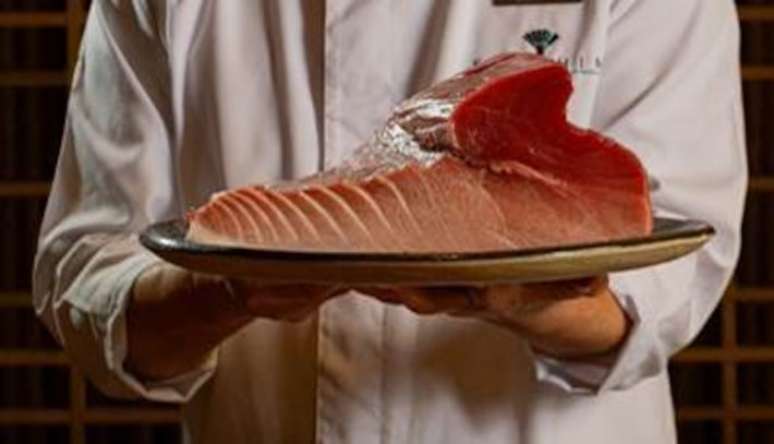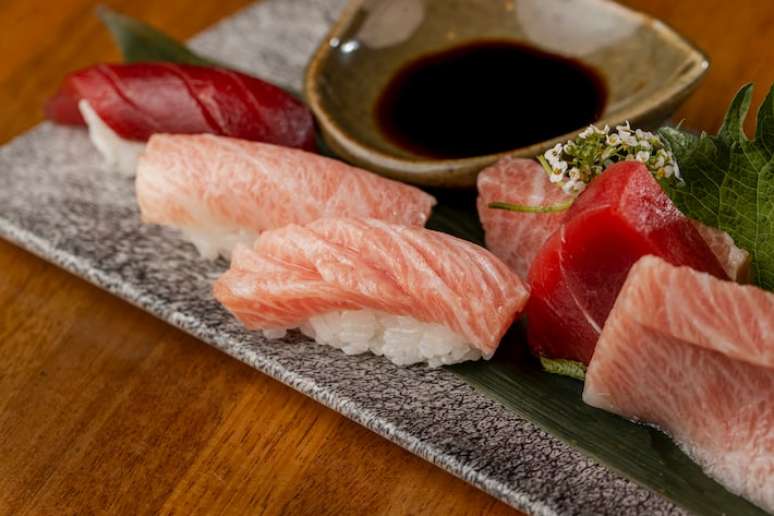Itaim’s restaurant serves red tuna sushi and sashimi until Friday
If you had come face to face with the fish in the middle of Kitchin’s room in Itaim Bibi, you would have known that it was not just any fish. The bluefin tuna, weighing nearly 140 kilos, was impressive for its size and deep red color, already announced by the absence of a tail.
“You know the story that they say it’s the first fish in the school that eats the most? This bluefin tuna is like that, it eats blue fish, from the sardine family,” said David Rodrigues, a sushi chef from Piaui, as he prepared to open the creature.
What is the tuna opening ceremony like?
In Spanish the ritual is called “ronqueo” (snoring) because of the sound the knife makes when it touches the animal’s spine. In Japanese kaitai refers to the ancient art of obtaining precise cuts from a tuna, usually red, weighing at least 100 kilos.

The craftsman who handles knives and cutting tools describes in detail the characteristics of the fish, tells its origin and, using the different parts of the noble tuna, prepares a tasting menu.
Despite more than a decade as a sushi chef, this was David’s second time hosting the ceremony: “This bluefin tuna weighs more than 130 kilos, has lived for at least two years and was caught using the ikejime technique, to prevent it from suffering.”
In addition to suffering, ikejime prevents the tuna from releasing lactic acid into its muscles, which gives the meat a metallic taste when stressed.
The Secrets of Kaitai
It takes time to master a fish of this size. Imagine, some live 8 years and have already broken records of over 4 meters and 750 kilos! In this sense you have to be meticulous and precise with the knife. After all, well cut, a fish like this would produce about 8,000 slices of sashimi…
It is important that the cuts are clean and straight, to best enhance the flesh of the tuna. “The only thing you should not do with a red tuna is waste it. And grill it. Which is basically the same thing, right?”, teaches David.
Origin of Bluefin Tuna
“In Brazil, when they arrive, the bluefin tuna come from the Mexican Pacific, Baja California or the Mediterranean Sea, like this one,” David explains. The tuna, like the one next to it, is generally caught in the spring of the Northern Hemisphere, between May and June. Then they go to “farms” about 100 kilometers from Barcelona, where they receive no food or antibiotics.

What does bluefin tuna omakase look like?
David has created a selection of sushi and sashimi with parts of the otoro (the fattiest and most expensive part of the red tuna, located in the belly), the akami (the lean part, near the back) and the chutoro (between the otoro and the akami, it is the most balanced part in fat content and flavor) and passes through the room with his sushi chefs who prepare temaki with very crunchy seaweed and red tuna tartare. The price of the menu is R$380.
For these sushi and tamaki, the chef prepares a shari (sushi rice, seasoned with a combination of vinegar, sugar and salt) different from what he usually serves at the restaurant: “For the red tuna, the shari has to be special, it has to have more acidity, they are cooked more al dente and they are more salty than sweet, as the Brazilian palate is used to.”
If there is a comment: the rice is a little more al dente, allowing the diner to feel the grains; warmer, it would generate a pleasant contrast of consistencies and temperatures.
Kitchen
R. Iaiá, 83, Itaim Bibi. Wednesday to Friday, 12:00 to 15:00 and 19:00 to midnight. Tel.: (11) 2339-2072
Source: Terra
Ben Stock is a lifestyle journalist and author at Gossipify. He writes about topics such as health, wellness, travel, food and home decor. He provides practical advice and inspiration to improve well-being, keeps readers up to date with latest lifestyle news and trends, known for his engaging writing style, in-depth analysis and unique perspectives.





![Tomorrow Belongs to Us: What’s in store for Friday 31 October 2025 Episode 2065 [SPOILERS] Tomorrow Belongs to Us: What’s in store for Friday 31 October 2025 Episode 2065 [SPOILERS]](https://fr.web.img4.acsta.net/img/27/7e/277e1f041c48016486ab18771f578de1.jpg)

